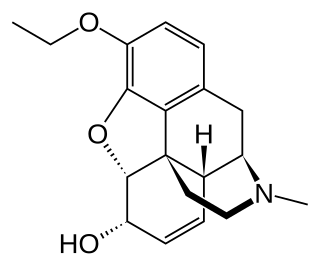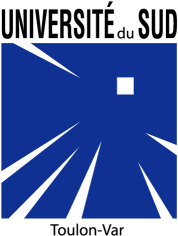
Promethazine is a first-generation antihistamine, antipsychotic, sedative, and antiemetic used to treat allergies, insomnia, and nausea. It may also help with some symptoms associated with the common cold and may also be used for sedating people who are agitated or anxious, an effect that has led to some recreational use. Promethazine is available by mouth in syrup or tablet dosage forms, as a rectal suppository, or by injection into a muscle.
The French National Institute of Nuclear and Particle Physics is the coordinating body for nuclear and particle physics in France. It was established in 1971 as a division of the French National Centre for Scientific Research (CNRS). Its purpose is "to promote and unite research activities in the various fields of physics".

Ethylmorphine is an opioid analgesic and antitussive.

Tiotixene, or thiothixene, sold under the brand name Navane among others, is a typical antipsychotic of the thioxanthene class which is related to chlorprothixene and is used in the treatment of psychoses like schizophrenia and bipolar mania. It was introduced in the United States in 1967 by Pfizer.

Chlorprothixene, sold under the brand name Truxal among others, is a typical antipsychotic of the thioxanthene group.

Thioxanthene is a chemical compound in which the oxygen atom in xanthene is replaced with a sulfur atom. It is also related to phenothiazine. Several of its derivatives are used as typical antipsychotics in the treatment of schizophrenia and other psychoses.

Pholcodine is an opioid cough suppressant (antitussive). It helps suppress unproductive coughs and also has a mild sedative effect, but has little or no analgesic effects. It is also known as morpholinylethylmorphine and homocodeine.

Tricyclics are chemical compounds that contain three interconnected rings of atoms.

Cloperastine (INN) or cloperastin, in the forms of cloperastine hydrochloride (JAN) and cloperastine fendizoate, is an antitussive and antihistamine that is marketed as a cough suppressant in Japan, Hong Kong, and in some European countries. It was first introduced in 1972 in Japan, and then in Italy in 1981.

Butamirate is a cough suppressant. It has been marketed in Europe and Mexico, but not in the United States.

Dimemorfan (INN), or dimemorfan phosphate (JAN), also known as 3,17-dimethylmorphinan, is an antitussive of the morphinan family that is widely used in Japan and is also marketed in Spain and Italy. It was developed by Yamanouchi Pharmaceutical and introduced in Japan in 1975. It was later introduced in Spain in 1981 and Japan in 1985.

Fenozolone (Ordinator) was developed by Laboratoires Dausse in the 1960s and is a psychostimulant related to pemoline.

The University of Toulon is a French university located in Toulon, France, and neighboring areas. It was founded in 1968 and is organized in 6 faculties, 2 autonomous institutes, an institute of business management and an engineering school.

Clopenthixol (Sordinol), also known as clopentixol, is a typical antipsychotic drug of the thioxanthene class. It was introduced by Lundbeck in 1961.

Cyclazodone is a centrally acting stimulant drug developed by American Cyanamid Company in the 1960s. The drug is related to other drugs such as pemoline and thozalinone. It displayed a favorable therapeutic index and margin of safety in comparison to Pemoline and other N-lower-alkyl-substituted Pemoline derivatives. The patents concluded that Cyclazodone possessed properties efficacious in reducing fatigue and as a potential anorectic. Structural congeners of Pemoline have been described as "excitants with unique properties distinguishing them from the sympathomimetic amines" whilst displaying less stimulatory activity and toxicity compared to amphetamine.

The École nationale supérieure de chimie de Lille was founded in 1894 as the Institut de chimie de Lille. It is part of the Community of Universities and Institutions (COMUE) Lille Nord de France.

Fenadiazole is a hypnotic drug with a unique oxadiazole-based structure. It used to be manufactured by the French pharmaceutical company Laboratoires Jacques Logeais.

Racemorphan, or morphanol, is the racemic mixture of the two stereoisomers of 17-methylmorphinan-3-ol, each with differing pharmacology and effects:

CRL-40,941 is a eugeroic closely related to adrafinil and modafinil. It is the bis(p-fluoro) ring-substituted derivative of adrafinil. CRL-40,941 was found to produce antiaggressive effects in animals, which adrafinil does not produce, and is purportedly 3 - 4 times stronger than adrafinil.

Thioxanthone is a heterocyclic compound that is a sulfur analog of xanthone.



















